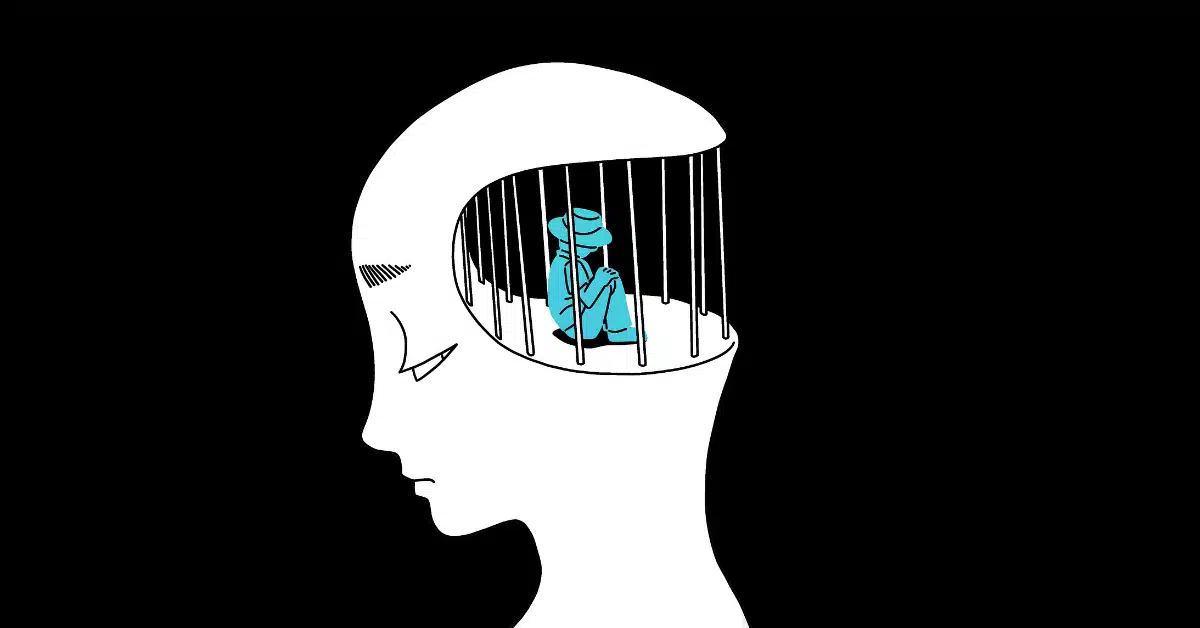Unshackle Your Mind and Embrace an Empowered Life
It can be challenging to overcome limiting beliefs from religious teachings that play a significant role in shaping our values, beliefs, and practices; it can be challenging to break free from the constraints of dogmatic teachings. The age-old traditions and doctrines that have been passed down through generations can create limiting beliefs that hinder personal growth and development. In this article, we will explore the process of overcoming these limiting beliefs, drawing from research papers, blog posts, news articles, and podcasts. The aim is to educate you on how to challenge and overcome the constraints imposed by religious dogma and embrace a more empowered and fulfilling life.
Understanding Limiting Beliefs and Religious Dogma
As human beings, we are all subject to a variety of beliefs, some of which are beneficial to our lives, while others are harmful. Limiting beliefs are a particular type of belief that can negatively affect our thoughts, emotions, and behaviors. These beliefs are often deeply ingrained and can be challenging to overcome. This article aims to define limiting beliefs, examine their relationship with religious dogma, and explore the psychological impact of these beliefs.
Defining Limiting Beliefs
Limiting beliefs are those beliefs that we hold about ourselves, others, and the world that limit our potential for growth and success. These beliefs can be conscious or unconscious, and they can be developed through our experiences, upbringing, culture, and environment. They can manifest in various forms, such as negative self-talk, self-doubt, fear of failure, and avoidance of risk.
Limiting beliefs can be classified into different categories, such as beliefs about our abilities, beliefs about others, beliefs about the world, and beliefs about the future. For instance, a person who believes that they are not intelligent enough to succeed in their career may avoid taking on challenging projects, leading to a lack of growth and advancement. Similarly, a person who believes that others are untrustworthy may have difficulty building meaningful relationships.
Religious Dogma and its Influence on Beliefs
Religious dogma refers to a set of beliefs and principles that are considered to be true and unchallengeable by a particular religion or denomination. These beliefs can be positive and life-affirming, such as the belief in the sanctity of life, compassion, and forgiveness. However, they can also be limiting and harmful, particularly when they are used to justify discrimination, intolerance, and violence.
One of the ways in which religious dogma can influence our beliefs is through indoctrination. Children who are raised in a particular religion may be taught to accept certain beliefs without questioning them critically. This can lead to the formation of limiting beliefs that are based on fear, guilt, and shame. For example, a person who is taught that sex is sinful and shameful may develop a limiting belief that their sexual desires are inherently wrong, leading to a distorted self-image and negative emotions.
Another way in which religious dogma can influence our beliefs is through selective interpretation. Religious texts can be interpreted in different ways, and some interpretations may promote limiting beliefs that are harmful to individuals and society. For example, some interpretations of the Bible may justify sexism, racism, and homophobia, leading to the perpetuation of discriminatory attitudes and behaviors.
The Psychological Impact of Limiting Beliefs
Limiting beliefs can have a profound psychological impact on our lives. They can affect our thoughts, emotions, and behaviors, leading to negative outcomes such as anxiety, depression, and low self-esteem. When we hold limiting beliefs, we may perceive the world through a negative lens, interpreting events and experiences in ways that reinforce our negative self-image.
Limiting beliefs can also lead to self-sabotage. When we believe that we are not capable of achieving our goals, we may avoid taking action, leading to a lack of progress and fulfillment. Additionally, limiting beliefs can prevent us from taking risks and pursuing our passions, leading to a life of mediocrity and regret.
Overcoming limiting beliefs requires self-awareness, courage, and perseverance. It involves identifying and challenging the beliefs that are holding us back and replacing them with positive, empowering beliefs. This process can be challenging, but it is essential for personal growth and fulfillment.
Identifying Your Limiting Beliefs
Limiting beliefs are negative thoughts and attitudes that we hold about ourselves and our abilities. These beliefs can hold us back from achieving our full potential, whether it be in our personal or professional lives. However, the first step in overcoming these limiting beliefs is identifying them. In this article, we will explore three effective methods for identifying your limiting beliefs: self-reflection and journaling, challenging and evaluating beliefs, and seeking feedback from trusted friends and family.
Self-Reflection and Journaling
Self-reflection and journaling are powerful tools for gaining insight into our thoughts and beliefs. When we take the time to reflect on our thoughts and feelings, we can uncover patterns and themes that may be holding us back. Journaling is an excellent way to record these insights and explore them further.
To begin self-reflection and journaling, set aside some time each day or week to focus on your thoughts and feelings. Find a quiet and comfortable space where you can write without distractions. Start by reflecting on your day or week and asking yourself questions like:
- What was I feeling today?
- What thoughts were running through my mind?
- What beliefs do I hold about myself and my abilities?
Write down your answers to these questions, and any other insights that come to mind. As you continue to journal, look for patterns and themes in your writing. Do you notice any recurring negative thoughts or beliefs? Once you have identified these patterns, you can begin to challenge and evaluate them.
Challenging and Evaluating Beliefs
Once you have identified your limiting beliefs, it’s time to challenge and evaluate them. Often, our limiting beliefs are based on inaccurate or outdated information, and by challenging them, we can begin to shift our perspective and overcome them.
To begin challenging and evaluating your beliefs, ask yourself the following questions:
- Is this belief based on facts or assumptions?
- Where did this belief come from?
- Is this belief helping or hindering me?
By answering these questions, you can gain a deeper understanding of your beliefs and begin to challenge them. For example, if you have a belief that you are not good enough to succeed in your career, ask yourself if this belief is based on facts or assumptions. Are there any concrete examples that support this belief, or is it simply a fear or insecurity?
Once you have identified the source of your belief, ask yourself if it is helping or hindering you. If it is hindering you, consider alternative perspectives or ways of thinking about the situation. For example, if you believe that you are not good enough to succeed in your career, challenge this belief by asking yourself what evidence supports this belief. You may realize that you have achieved success in the past or that you have the skills and experience necessary to succeed.
Seeking Feedback from Trusted Friends and Family
Another effective way to identify your limiting beliefs is to seek feedback from trusted friends and family. Often, our beliefs are so deeply ingrained that we may not even be aware of them. By seeking feedback from others, we can gain a fresh perspective on our thoughts and behaviors.
When seeking feedback from others, it’s important to choose people who know you well and who will provide honest and constructive feedback. Ask them questions like:
- What do you see as my strengths and weaknesses?
- Do you think I have any limiting beliefs that are holding me back?
- What advice would you give me to overcome these beliefs?
Listen to their feedback with an open mind, and try to avoid becoming defensive or dismissive. Remember, the goal of seeking feedback is to gain insight and perspective, not to prove yourself right or wrong.
Strategies for Overcoming Limiting Beliefs
Limiting beliefs can hinder one’s ability to achieve their goals and live a fulfilling life. These beliefs are often self-imposed and can hold us back from taking risks, trying new things, and reaching our full potential. However, with the right strategies and mindset, these beliefs can be overcome. In this article, we will discuss three strategies for overcoming limiting beliefs: Cognitive Behavioral Therapy (CBT), Mindfulness and Meditation, and Exposure to Diverse Perspectives and Open Dialogue.
Cognitive Behavioral Therapy (CBT)
Cognitive Behavioral Therapy (CBT) is a form of talk therapy that aims to change negative thought patterns and behaviors. It focuses on identifying and challenging negative beliefs and replacing them with more positive and constructive ones. CBT is effective in treating anxiety, depression, and other mental health disorders, as well as improving overall well-being.
One of the main principles of CBT is that our thoughts, feelings, and behaviors are interconnected. By changing our thoughts, we can change our feelings and ultimately our behaviors. For example, if someone has a fear of public speaking, they may have negative thoughts such as “I’m going to mess up” or “Everyone is going to judge me.” These thoughts can lead to anxiety and avoidance behaviors. Through CBT, a therapist can help the individual challenge these thoughts and replace them with more positive ones, such as “I have prepared for this and can do it well” or “Everyone is here to learn, and they want me to succeed.”
CBT involves several techniques, including journaling, role-playing, and exposure therapy. Journaling is a helpful tool for identifying negative thought patterns and tracking progress in replacing them with positive ones. Role-playing can be used to practice challenging negative beliefs in a safe environment. Exposure therapy involves gradually exposing oneself to a feared situation, such as public speaking, in a controlled setting. Through these techniques and the guidance of a trained therapist, individuals can learn to identify and challenge their limiting beliefs and replace them with more positive and constructive ones.
Mindfulness and Meditation
Mindfulness and meditation are practices that involve focusing on the present moment and observing one’s thoughts and emotions without judgment. These practices can help individuals become more aware of their negative thought patterns and learn to respond to them in a more constructive way. Mindfulness and meditation have been shown to reduce stress, anxiety, and depression and improve overall well-being.
One of the main principles of mindfulness is acceptance. Instead of trying to suppress or avoid negative thoughts and emotions, individuals are encouraged to observe them without judgment and accept them as part of the human experience. Through this acceptance, individuals can learn to respond to their thoughts and emotions in a more constructive way, rather than letting them control their behavior.
Meditation is a practice that involves focusing on the breath or a specific object and observing one’s thoughts and emotions without judgment. It can be done in a seated position, lying down, or even while walking. Through regular practice, individuals can learn to become more aware of their thought patterns and respond to them in a more constructive way.
Exposure to Diverse Perspectives and Open Dialogue
Exposure to diverse perspectives and open dialogue is a strategy for overcoming limiting beliefs that involve seeking out different perspectives and engaging in open dialogue with others. This can help individuals challenge their assumptions and biases and expand their understanding of the world.
One of the main benefits of exposure to diverse perspectives is that it can challenge one’s assumptions and biases. When we only surround ourselves with people who think and act like us, we can become trapped in a narrow worldview. By seeking out different perspectives, we can broaden our understanding of the world and challenge our limiting beliefs.
Open dialogue is another important aspect of this strategy. By engaging in open and respectful dialogue with others, we can better understand their perspectives and challenge our own assumptions. This can help us develop empathy and compassion for others, as well as promote a more tolerant and inclusive society.
There are many ways to expose oneself to diverse perspectives and engage in open dialogue. One way is to read books and articles written by people from different backgrounds and cultures. This can help us gain a better understanding of different perspectives and worldviews. Another way is to attend cultural events or participate in activities that bring people from different backgrounds together. This can provide opportunities to learn from others and engage in meaningful conversations.
Social media can also be a powerful tool for exposure to diverse perspectives and open dialogue. However, it’s important to approach social media with a critical eye and be aware of the potential for misinformation and bias. Following people and organizations from diverse backgrounds and engaging in respectful dialogue can be a helpful way to broaden one’s understanding of the world.
Embracing a Growth Mindset and Empowerment
As humans, we all have the capacity to learn, grow, and achieve great things. However, our ability to do so can be hindered by our own limiting beliefs and negative self-talk. That’s where the concept of a growth mindset comes in – the belief that our abilities and intelligence can be developed through dedication and hard work. In this article, we’ll explore the importance of embracing a growth mindset and empowerment in our lives, and how it can lead to developing a positive self-image, pursuing personal goals and dreams, and building resilience and perseverance.
Developing a Positive Self-Image
One of the key components of a growth mindset is having a positive self-image. When we believe in ourselves and our abilities, we are more likely to take risks, try new things, and push ourselves to achieve our goals. On the other hand, if we have a negative self-image and believe that we are not capable of achieving success, we are more likely to give up before we even try.
So, how do we develop a positive self-image? One way is to focus on our strengths and accomplishments, rather than our shortcomings and failures. We can do this by keeping a gratitude journal, where we write down things we are thankful for each day, or by celebrating our achievements, no matter how small they may seem.
Another way to develop a positive self-image is to surround ourselves with positive people who encourage and support us. When we are around people who believe in us and our abilities, we are more likely to believe in ourselves as well.
Pursuing Personal Goals and Dreams
When we have a growth mindset and a positive self-image, we are more likely to pursue our personal goals and dreams. We believe that we are capable of achieving success, and we are willing to put in the work to make it happen.
However, pursuing our goals and dreams can be challenging. We may face obstacles and setbacks along the way, and it can be easy to give up when things get tough. That’s where building resilience and perseverance come in.
Building Resilience and Perseverance
Resilience is the ability to bounce back from adversity and continue moving forward, despite the challenges we may face. Perseverance is the determination to keep going, even when things seem impossible.
Both resilience and perseverance are important traits to develop if we want to achieve our goals and dreams. Here are some ways to build these traits:
- Reframe failure as a learning opportunity. When we experience failure, it can be easy to get discouraged and give up. However, if we reframe failure as a learning opportunity, we can use it to improve and grow.
- Set realistic goals. It’s important to set goals that are challenging, but also realistic. If our goals are too difficult to achieve, we may become discouraged and give up. On the other hand, if our goals are too easy, we may not feel challenged enough to keep going.
- Break big goals into smaller, manageable tasks. When we have a big goal, it can be overwhelming to think about all the steps we need to take to achieve it. By breaking it down into smaller, manageable tasks, we can make progress without feeling overwhelmed.
- Practice self-care. Taking care of ourselves physically, mentally, and emotionally can help us build resilience and perseverance. This includes getting enough sleep, eating healthy foods, exercising regularly, and practicing relaxation techniques like meditation or yoga.
- Surround ourselves with supportive people. Just as positive people can help us develop a positive self-image, supportive people can help us build resilience and perseverance. When we have people in our lives who believe in us and encourage us, we are more likely to keep going when things get tough.
Case Studies and Success Stories
As human beings, we are constantly faced with challenges that test our limits and push us out of our comfort zones. It’s easy to get stuck in limiting beliefs or dogmatic teachings that prevent us from realizing our full potential. However, there are many individuals and communities who have overcome these obstacles and achieved great success. In this article, we’ll explore case studies and success stories of individuals who overcame limiting beliefs, communities that challenged dogmatic teachings, and inspiring podcasts and blog posts that can help motivate and inspire us to achieve our own goals.
Individuals Who Overcame Limiting Beliefs
Limiting beliefs are the negative thoughts and self-talk that hold us back from achieving our goals. They can be deeply ingrained in our minds and difficult to overcome, but with determination and a growth mindset, anything is possible.
One example of an individual who overcame limiting beliefs is J.K. Rowling, author of the Harry Potter series. Rowling was a struggling single mother living on welfare when she began writing her first book. Despite facing rejection from numerous publishers, she persevered and eventually found success. Today, she is one of the most successful authors in history, with millions of fans around the world.
Another inspiring example is Nick Vujicic, a motivational speaker and author who was born without arms or legs. Despite facing numerous challenges throughout his life, Vujicic has achieved incredible success, inspiring millions with his positive attitude and determination.
Communities That Challenged Dogmatic Teachings
Dogmatic teachings can be deeply ingrained in our culture, religion, or society. They can be difficult to question or challenge, but doing so can lead to new perspectives and personal growth.
One example of a community that challenged dogmatic teachings is the LGBTQ+ community. For many years, society’s dogmatic teachings about sexuality and gender limited the rights and freedoms of LGBTQ+ individuals. However, through activism and advocacy, the community has made significant progress in achieving equality and acceptance.
Another inspiring example is the Civil Rights Movement of the 1960s. African Americans faced systemic racism and discrimination for centuries, but through peaceful protests and civil disobedience, they challenged the dogmatic teachings of white supremacy and segregation. The movement paved the way for significant social and political change in the United States.
Inspiring Podcasts and Blog Posts
In addition to real-life examples of individuals and communities who have overcome limiting beliefs and challenged dogmatic teachings, there are also many inspiring podcasts and blog posts that can help motivate and inspire us to achieve our own goals.
One inspiring podcast is “The School of Greatness” with Lewis Howes. Howes interview successful entrepreneurs, athletes, and celebrities, discussing their journeys to success and the lessons they learned along the way.
Another inspiring blog post is “The Habits of Highly Successful People” by James Clear. Clear shares the habits and routines of successful individuals, providing actionable tips for readers to implement in their own lives.
Conclusion:
Breaking free from the constraints of religious dogma and overcoming limiting beliefs is a journey of self-discovery and personal growth. By understanding the nature of limiting beliefs, identifying and challenging them, and adopting strategies for personal empowerment, individuals can embrace a more fulfilling and authentic life





